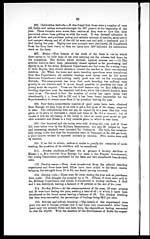Medicine - Veterinary > Civil Veterinary Departments > Annual administration report of the Civil Veterinary Department of India > 1907-1908 > Part B - Imperial administration
(42) Page 31
Download files
Individual page:
Thumbnail gallery: Grid view | List view

31
jowar we did last year. Hail also damaged the oat crop considerably. It is
satisfactory to note, however, that notwithstanding all the difficulties we have
been able to carry on and maintain the stock in excellent condition during
the year and have 59,000 maunds of dry fodder in hand.
198. Foot and mouth disease was very troublesome and two outbreaks
occurred during the year. It was very mild but caused some deaths in calves.
Blackleg was also prevalent causing considerable loss, and arrangements have
now been made to inoculate all the young stock with vaccine as a preventive.
The disease has been enzootic on the farm for many years and as the virus is
so tenacious of life, is a constant danger and source of loss. It is hoped that
by means of inoculation we shall be able to reduce the mortality very consider-
ably.
299. Breeding herd—Herd Bulls.—The number of herd bulls at the
beginning of the year (Table XVI) was only 19 which, allowing for sickness
and casualties, was insufficient. None were obtained from outside as they
can only be bought in exceptional circumstances. Six of the most promising
of the male farm bred stock were selected and three of these are now with
the herds. This brings the number up to 22 which is still insufficient. There
are some splendid bulls amongst them but others are not so good. The question
of making suitable provision for obtaining the very best possible bulls for the
herds in the future is a most important one and with a view to meeting the
requirements, a system has now been introduced by which any particularly
promising young bull calf out of the best of the cows will be set apart at
an early age so that he will receive a little extra care and attention and have
every chance of developing into a good herd bull. A start has already been
made and the scheme will do much to obviate the difficulty.
200. Cows.—The herd at the beginning of the year consisted of 1,038
cows, and 177 farm bred heifers were added by transfer. The herd was very
carefully examined with the result that 98 old, barren, or otherwise useless
cows were weeded out. 18 died and 2 were destroyed during the year, leaving
the number in the herd 1,097 at its close. It is therefore somewhat short of
the number, 1,200, which is considered to be the maximum.
201. Male produce.—The number of male produce rose from 799 to 900.
There were 292 births bringing it up to 1,091 of which 127 were transferred
to supernumerary bulls, 21 were sold as unfit and 43 died chiefly from Blackleg
and Foot and mouth disease.
202. Female produce.—There was a slight decrease in the number of
female produce. At the beginning of the year, there were 736 and 285 cow
calves were born, bringing the number up to 1,021. Of these, 177 were
transferred to the breeding herd, 37 died, 2 were destroyed and 106 were cast
and sold as unfit. The number of casting was considerable but in a herd of this
description where the blood of the stock with which we started operations was
so mixed and where our object is to obtain a more or less uniform type, it is
impossible to avoid careful and extensive weeding out of all unsuitable female
produce showing great deviation from the type we are aiming at. The result
of this heavy weeding is that the number of female produce has fallen to 699.
The rejections should, however, be far less next year as the herds were most
carefully examined so as to remove all bad ones found.
203. It has been found necessary with a view to ascertaining which cows
were throwing unsuitable stock and which the best, to start a herd book. It
was found under the old system, impossible to ascertain which cows were
suitable for retention and which not as the parentage of the stock was not
known.
204. Calves.—577 calves were born during the year against 582 last year.
This may be considered very satisfactory when the insufficiency of our herd
bulls is taken into consideration,
205. Supernumerary Bulls.—Of these, owing to famine conditions prevail-
ing, only 69 were issued to districts and 9 were sold to other Provinces.
Set display mode to: Large image | Zoom image | Transcription
Images and transcriptions on this page, including medium image downloads, may be used under the Creative Commons Attribution 4.0 International Licence unless otherwise stated. ![]()
| Permanent URL | https://digital.nls.uk/75509612 |
|---|




